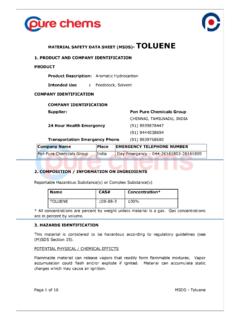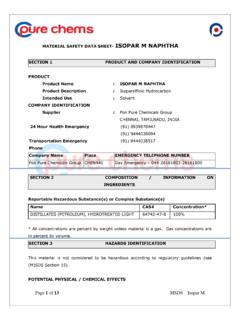Transcription of Lightning Protection as Per IEC 62305 & Key …
1 IOSR Journal of Electrical and Electronics Engineering (IOSR-JEEE) e-ISSN: 2278-1676,p-ISSN: 2320-3331, Volume 12, Issue 5 Ver. I (Sep. Oct. 2017), PP 37-41 DOI: 37 | Page Lightning Protection as Per IEC 62305 & Key Factors of Installation, Maintenance *Dr. K. Janakiraman., Senior Manager Product Development, M/s. OBO Bettermann INDIA PVT LTD., India (The Author is also a Representing Member of National Building Code BIS) Corresponding Author: Dr. K. Janakiraman. Abstract: The basic interest of this paper is to discuss and insist on the importance of Protection devices / system and to regulate the overall process including selection, installation and upkeep of the Lightning Protection system in place for many years down the line of installation. Not limiting to the orientation of the product technicality or specification, the most important thing that is left out off-late is the Good Practices to be maintained in implementing and maintaining the same.
2 Many installations across the world for Lightning Protection device just confirm to the requirement criterion of merely having a terminal on top and further completion of system are not followed. This paper will help in understanding the issues of various installation procedures and fool proof method of recommending and implementing Lighting Protection System, Earthing and Surge Protection System. This paper also will define about, how a selection of Lightning Protection device is to be done, the basis of installation and utilization of component. Keywords: Complete Solution against Lightning , Lightning Protection , Maintenance & Installation aspects of Lightning Protection system ---------------------------------------- ---------------------------------------- ---------------------------------------- --------------- Date of Submission: 15-09-2017 Date of acceptance: 23-09-2017 ---------------------------------------- ---------------------------------------- ---------------------------------------- --------------- I.
3 Introduction The most important aspect of understanding in Lightning Protection is that - not only a direct Lightning strike act as a potential threat to the structure but also more frequently, electronic equipment are damaged by surges caused by remote Lightning discharges (caused because of Lightning Electromagnetic Impulses LEMPs)or switching operations in larger electrical systems. During thunderstorms too, high volume of energy is instantaneously released. These voltage peaks can penetrate a building through Power, Data and Telephone cables causing heavy damage to Electronic Equipment. The international standard for Lightning Protection referred as IEC 62305 Protection against Lightning , (which is also accepted by many countries as national standard) especially adopted by Bureau of Indian standard as IS IEC 62305 , in one of its part explains the need of planning, erection, testing and maintenance of Lightning Protection systems for building structures without any height limit.
4 The same is also implemented in new National Building Code 2016, Part -8, Section 2 which also clearly defines the need of the measures to be taken care for planning, erection, testing and maintenance of Lightning Protection system. The standard IEC 62305 in its second part Risk Management categorizes the four sources of Lightning as 1. Flashes to a structure, 2. Flashes near to a structure 3. Flashes to a service line, 4. Flashes near to a service line. Fig 1 : Representation of different sources of Lightning (picture courtesy IEC 62305 -4) Lightning Protection As Per IEC 62305 & Key Factors Of Installation, Maintenance DOI: 38 | Page A proper Lightning Protection system design is very important to ensure increased Protection of a building against Lightning and its effects. Systems followed in most of the buildings now are unfortunately not meeting the basic or statutory requirements.
5 Since only a mere vertical air terminal will not solve the purpose for Protection of building unless the entire building is sufficiently protected either with 1. Angle of Protection method 2. Mesh conductor method or calculated as per rolling sphere method. It is important to remember any best Lightning Protection implemented in the structure will not protect the personal outside the building (within the premises where the building is located). Since the angle of Protection offered by the Lightning Protection terminal will only protect against direct strike, however induced step and touch potential will not be protected and which will lead to electrocution and causalities thereafter. The standard practice of using external Lightning Protection system is to handshake with the downward leader of the Lightning strike and ensure the Lightning does not strike anywhere else in the structure. A proper Lightning Protection system, should consist of three prime components in principal Air termination (vertical or horizontal mesh), down conductor and earthing system and should also offer a least resistance path for the discharge of Lightning current.
6 This measure should not be mis-understood that by providing external Lightning Protection our entire equipment / devices will get protected from damage. Separate measures as recommended in IEC 62305 -4 Protection against Lighting: Electrical and Electronic system within the structure need to be followed and a proper and respective Surge Protection Device (SPDs)need to be employed individually for power line, data line and coaxial line for various application such as electronic appliances, internet modems, television etc. Assume a television has failed due to Lightning , the Protection measure for that Television should be co-ordinated by employing SPDs at both power and Data inputs (satellite cable - coaxial cable terminated) since both sources are vulnerable of carrying Lightning current. If this method is practiced then damages can be avoidedfor such systems even if connection remains plugged. In both external Lightning Protection system and internal Lightning Protection system (SPDs) Earthing is an inevitable component, without which in both the cases dissipation of current is possible.
7 Hence properly selected and properly maintained earthing is also needed for maximum safety in consolidation. II. Effective Lightning Protection Measures Proper measures are to be taken care of while designing, procuring and installing of lighting Protection components for handling a strike and dissipation of current without any dangerous spark overs. For buildings are surrounded by trees, or a taller metallic tower the Protection measures should include not only Lightning Protection but also required ring earthing around the building and Surge Protection for the equipment since the fatality due to lighting could be more disastrous for an equipment than a structural damage. Fig - 2 : Sample representation of Lightning Protection , Surge Protection and Earthing for building located near metallic structure. Lightning Protection As Per IEC 62305 & Key Factors Of Installation, Maintenance DOI: 39 | Page Moreover the installed protective devices tend to lose their visibility in due course due to various reasons.
8 Periodic maintenance, monitoring and certification should be made mandatory for the effective functioning of the protective devices installed. For Protection of Electrical, wiring, Electrical and electronic equipment, installation of Surge Protection Devices should be adopted. Lightning Protection is often a challenge for the building designer when it comes to aesthetics of the building. Routing of down conductors through outer wall generally spoil the aesthetics of the building, due to which the down conductors are often routed through shafts, un-accessible areas, non-visible places etc. These down conductor increases the chance of fire and explosion in case of Lightning . As a statutory requirement Lightning Protection is implemented in most of the buildings, but unfortunately in an inefficient way. Lightning flashes to, or nearby, structures (or lines connected to the structures) are hazardous to people, to the structures themselves, their contents and installations need to be considered for Protection measures.
9 An effective Lightning Protection is achieved only if the following points are adhered viz., Type of Protection Level of Protection based on risk assessment Technically qualified product as per latest and relevant IEC standards Sizes and dimensions of components Location of Air terminal& coverage Conductor routing and connections Sufficient and required Earthing provisions Proper Utilization natural components as down conductor if applicable. III. Design Guidelines The following design guidelines need to be adhered to ensure safer installation of the external LPS. A down-conductor should be installed at each exposed corner of the structure where this is possible. The down-conductors should form a direct continuation of the air-termination conductors Straight and vertical so that they provide the shortest and most direct path to earth The formation of loops in bring the down conductor shall be avoided, but where this is not possible the distance s shall be maintained.
10 Connection of down conductors to gutters or down-spouts even if they are covered by insulating materials. Usage of multiple connection with different materials should not be permitted. Insufficient conductor dimensions (non-complying material as mentioned in IEC 62305 -3 Table 5) should be strictly avoided. When the distance from down conductors to combustible materials can not be assured, the cross section of the down conductor shall not be less than 100 mm The electrical insulation between the air-termination or down-conductors and the structural metal parts, the metal installations and the internal systems can be achieved by providing a distance d between the parts greater then the separation distance s . S = (Ki) x {Kc/Km} x L Where: Ki -depends on the selected class of LPS Kc - depends on the Lightning current flowing on the down conductors Km - depends on the electrical insulation material L - length in meters along the air-termination or down-conductor, from the point where the separation distance is to be considered, to the nearest EPB point Selection of Zonal Concepts need to be analyzed (LPZ- Lightning Protection Zones) in the IS / IEC standards.














